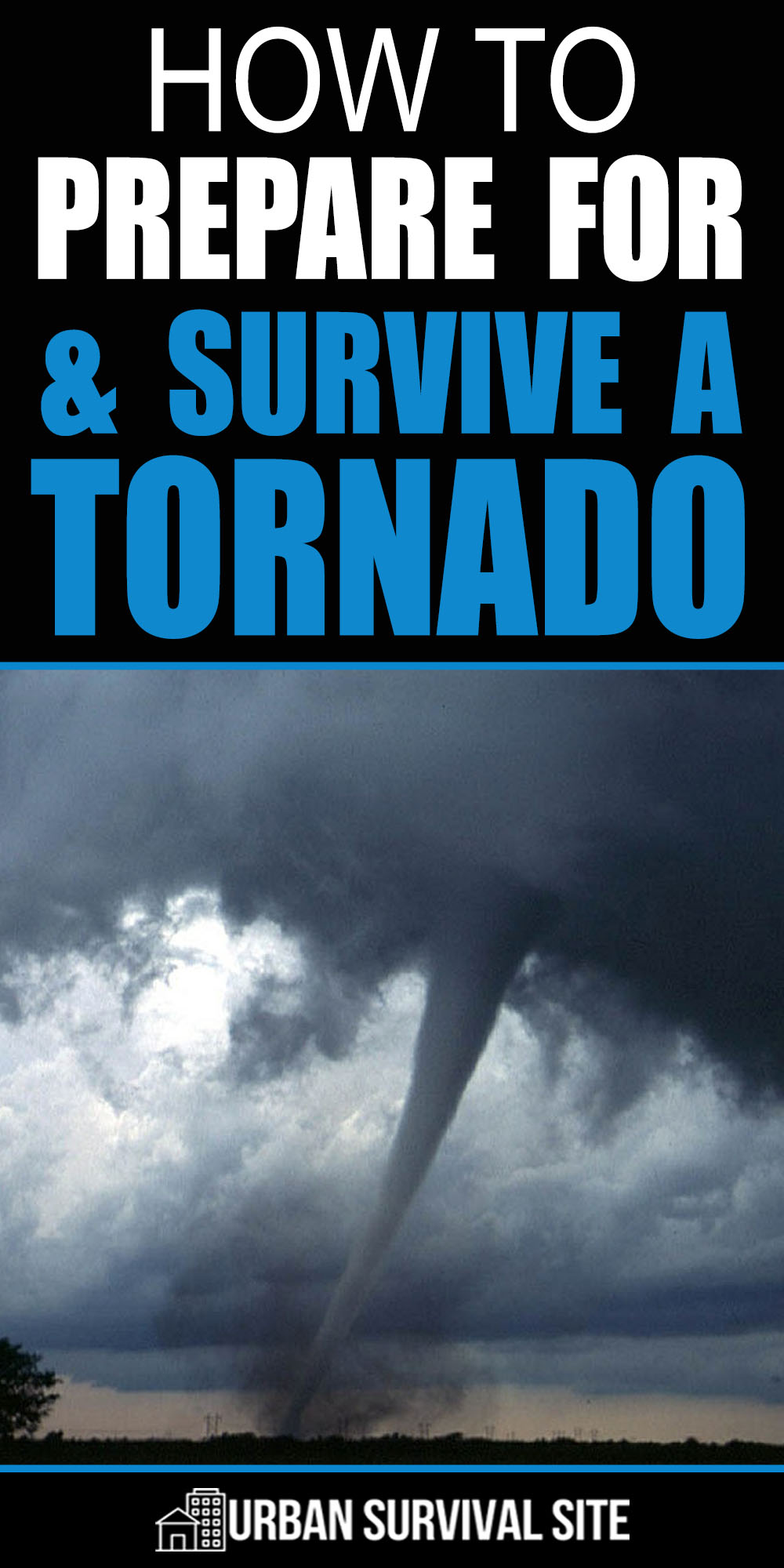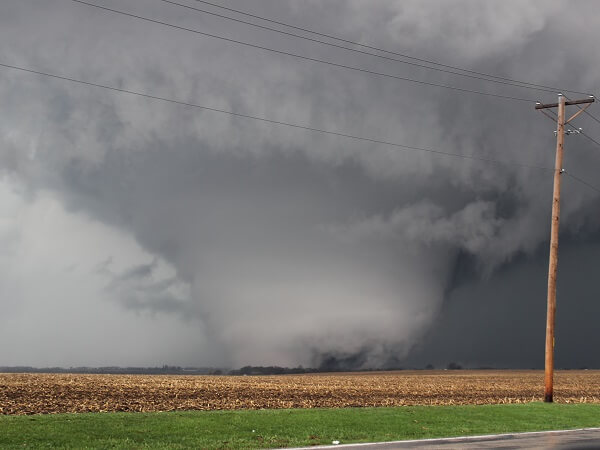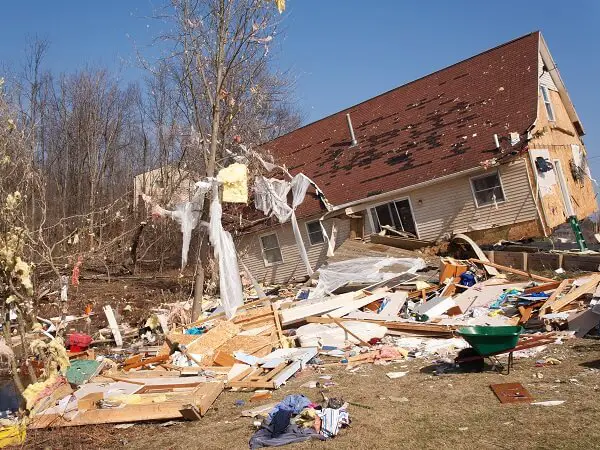How To Prepare For And Survive A Tornado was first seen on http://totalsurvival.net/


 They can flip cars, rip the roofs from homes, and hurl swirls of debris — including tree trunks and pieces of buildings — with incredible force. Tornadoes are vertical funnels of spinning, rotating air. Their powerful winds can exceed 250 miles per hour, and they can wreak swaths of havoc up to one mile wide and 50 miles long.
They can flip cars, rip the roofs from homes, and hurl swirls of debris — including tree trunks and pieces of buildings — with incredible force. Tornadoes are vertical funnels of spinning, rotating air. Their powerful winds can exceed 250 miles per hour, and they can wreak swaths of havoc up to one mile wide and 50 miles long.
With an average of 1,000 storms per year, the United States has the world’s most tornadoes, and tornadoes cause an estimated 80 fatalities and 1,500 injuries annually. Tornadoes are more likely to occur in the spring and summer, but they can happen anywhere and at any time of year under the proper conditions.
Want to save this post for later? Click Here to Pin It on Pinterest!
The region that includes South Dakota, Kansas, Nebraska, Oklahoma, eastern Colorado, and northern Texas — called Tornado Alley — has the most powerful of these storms.
A tornado’s distinctive funnel cloud consists of water droplets and swirling dust and debris. Although some tornadoes can move at an astonishing 70 miles per hour, most move at 10 to 20 miles per hour and rarely travel more than six miles in distance.
Tornadoes are classified as violent, strong, or weak storms. As you might expect, it is the violent storms that are the deadliest. Although they include only two percent of all twisters, violent tornadoes last the longest and cause 70 percent of all tornado deaths. Most deaths occur from injuries caused by flying debris.
As spring approaches, it is important to know the warning signs of tornadoes. Most municipal warning systems can alert residents within 13 minutes that a storm is in the vicinity. There are two types of alerts:
- A “Tornado Watch” means that conditions are right for a tornado.
- A “Tornado Warning” means a tornado has been sighted in the area.
Be sure to register for your community’s warning system and become familiar with the sirens your community may use to alert residents to storm danger. The National Oceanic and Atmospheric Administration (NOAA) and the Emergency Alert System (EAS) also offer tornado alerts.
Natural warning signs include a dark greenish sky; a large, dark, low-lying cloud; a hailstorm; and approaching winds that many people describe as sounding like a freight train.
If you see the warning signs or hear a “Tornado Warning” alert, it is critical that you and your family seek shelter immediately. Contrary to myth, do not open windows before a tornado. This practice will not prevent damage to your home and may contribute to injuries from flying glass and debris.



How To Find Shelter
- Find a basement, storm cellar, or interior room on the lowest floor that has no windows. A bathroom, closet, or center hallway will work. For added protection, you can get beneath something sturdy such as a heavy table or a workbench. Cover your body with a sleeping bag, mattress, or blanket and protect your head with your hands, a blanket and anything else that is available.
- If you are in a tall building, you may not have enough time to go to the lowest floor. Instead, choose a hallway in the center of the building.
- Mobile homes are not safe during a tornado. You must seek shelter in a sturdy building.
- If you cannot quickly walk to a shelter, drive to the closest sturdy structure, staying away from bridges and highway overpasses.
- If you encounter strong winds or flying debris while you are driving, pull over in a flat location and park. Do not try to outrun the storm! Keep your seat belt on and the engine running. Lower your head down below window level and cover it with your hands and a blanket. Listen to local news or NOAA Weather Radio for information and instructions.
Making Your Home Safer
Although advertisements for some windows and doors boast that they are “tornado-proof,” be wary of the claims. For a home to be tornado-proof, it must be missile-proof, according to the Federal Emergency Management Agency (FEMA). That is because projected debris is the deadliest aspect of the storm.
The weakest parts of your home are its doors and windows. Garage doors, in particular, are especially vulnerable. Most garage doors are weak enough that a large rush of wind can enter your home easily, causing intense pressure that can literally bring down the walls and even the ceiling.
No one wants to have a windowless, door-less home, but there is something you can do. If you want to offer your family better protection during a violent tornado or hurricane, you may want to consider adding a safe room in your home.
When built to standards set by FEMA, a safe room offers “near-absolute” protection in extreme weather events. Residential safe rooms must be accessed through a door or other opening. The strength of the doorway is critical to the integrity of the safe room.
Even though they appear strong, the types of steel doors often used in residential and commercial buildings will not withstand the impact of the propelled debris in a violent tornado. Only door and hinge assemblies that have been designed and tested to withstand extreme pressure and impact qualify for FEMA approval for safe rooms.
To earn this approval, doors and door assemblies must meet or exceed current standards set by the International Code Council of the National Storm Shelter Association. Visit the FEMA website for more information.
If it is impractical to build a safe room in your home, it is possible to convert an interior room in your home to meet the criteria, according to FEMA. Internal (meaning no windows) bathrooms or large closets are examples of rooms you might consider modifying for this purpose.



If you have a safe room or a basement or cellar designated as an emergency storm shelter, here is a list of items to put in there:
- Sturdy shoes and socks for each family member.
- Long sleeve shirts, long pants, and work gloves for each family member.
- Flashlights with fresh batteries. If you use candles for lighting, be careful to place them in sturdy holders away from any flammable items. Do not leave a candle burning when you are out of the room.
- Battery powered or hand crank radio.
- Battery powered phone charger.
- Water, snacks, and non-perishable food.
- One blanket for each family member and sleeping bags.
- Coloring books, cards, games, and puzzles.
- First aid kit.
- Tool box with basic hand tools (hammer, handsaw, pliers, screwdriver, utility knife) for use after the storm.
- Portable generator (to be operated in the open at a safe distance from home after the storm has passed).
- Roof repair items such as tarps, plastic sheeting, duct tape, and felt nails).
- Cash.
- Copies of insurance documents and a home inventory.
- Pet leashes, pet carriers, pet food.
- Medicines and prescriptions.
After The Tornado
When you hear the all-clear after a tornado, you never know what you may encounter. Use extreme caution as you explore your home and property for damages.
A study after a tornado in Marion, Illinois revealed that 50 percent of storm-related injuries were suffered after the storm during rescue attempts and cleanup activities. Nearly one-third of the injuries came from people stepping on nails. Wear sturdy shoes, long sleeves, long pants, and gloves when moving through storm debris.
Other common post-tornado injuries are caused by falling objects or from lifting heavy objects. Avoid any areas that may have downed electrical wires or damaged gas lines.
Tornadoes heighten the risk of electrocution, fire or explosion. If you suspect any damage to your home, turn off electrical power, natural gas, and propane tanks. Notify the gas company, the police or fire departments, or State Fire Marshal’s office. If you smell any suspicious fumes or odors, do not turn on the lights, light matches or candles, or do anything that could ignite a fire.
If you smell gas, turn off the main gas valve, leave the house immediately, and notify the gas company as well as the police or fire departments.
Talk About Tornadoes
Educate your children about tornadoes so they will be better prepared to follow emergency procedures if the time comes. Hold mock storm drills during which you visit your designated shelter and discuss the steps you all need to follow.
Watch a video or read a book about tornadoes with your children and ask them if they have any questions. Answer their concerns as best you can and assure them that the storm will not last long and that you will be together. Include children in clean-up activities after the storm, assigning them age-appropriate jobs.
Although you cannot predict or prevent tornadoes, there is much you can do in advance to protect your family.
Like this post? Don’t forget to Pin It on Pinterest!
This article first appeared on urbansurvivalsite.com See it hereLearn More Here: How To Prepare For And Survive A Tornado

No comments:
Post a Comment